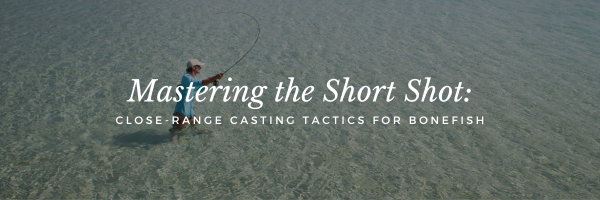When most anglers picture a shot at a bonefish, they imagine a long cast to a distant cruiser—plenty of time to false cast, gauge distance, and deliver the perfect presentation. But the reality on the flats? A lot of your best opportunities will be close, fast, and unexpected.
At East End Lodge, many fish are spotted just 10 to 25 feet off the bow. These short shots demand precision, speed, and control—all without spooking the fish. And they’re often the ones that separate a good day from a great one. Here’s how to master the short game when targeting bonefish in skinny water.
Why Close-Range Shots Matter
Bonefish love shallow flats, and when the tide is right, they’ll push in so close that you’ll sometimes see them before your guide does. But at these close distances, you don’t get a second chance. A splashy cast or hesitation can spook the fish instantly.
Short shots are also common when wading. The fish might be feeding toward you, and suddenly, it’s within 15 feet. In that moment, you need to react instinctively—and confidently.
Strip Fewer Times, Cast Less Often
The key to a successful short shot is eliminating extra movement. This is not the time for multiple false casts or hero loops. Get your fly in front of the fish fast with a short, tight, accurate cast.
Practice starting with line already out of the rod tip—this gives you a head start. Strip once, maybe twice, and shoot the line. Your goal is to have your fly land gently and immediately get in position to move.
Keep the Rod Low and the Loops Tight
When casting to a fish 15-25 feet away, a high rod tip and open loop can lead to slack, poor accuracy, and a fly that splashes down too hard.
Instead:
- Keep your rod tip low to the water on both the forward and back cast.
- Focus on short, crisp strokes to create tight loops.
- Avoid high back casts—this creates extra distance and too much energy for close shots.
Minimize Line on the Water
In close quarters, too much fly line on the water is a liability. Bonefish are hypersensitive to shadows, movement, and noise.
Use a shorter leader (8-9 feet) and minimal fly line, especially if you’re casting into skinny water or in a crosswind. This allows you to present the fly cleanly with as little disturbance as possible.
Be Ready with the Rod Pointed In the Right Direction
This is one of the easiest habits to build—and one of the most overlooked. Between casts or while scanning the flats, always keep your rod tip pointed in the direction your guide is watching.
When a fish appears suddenly, you won’t waste time reorienting your rod. You’ll already be facing the right direction, and a quick strip-cast is all it takes to get your fly in play.
The Roll Cast Advantage
In tight spots with little time, a well-placed roll cast can be your best weapon. If you’re wading and can’t get a full back cast, or if the fish appears almost under your rod tip, a roll cast gets your fly out cleanly with minimal movement.
Practice your roll cast in wind, at different angles, and at short distances. It’s a technique that pays off often—especially when fish appear closer than expected.
Control the Strip—Don’t Overdo It
When a fish eats at short range, there’s a strong temptation to set the hook too hard or strip too far. But at this distance, even a small movement can rip the fly right out of the fish’s mouth.
Instead, keep your first strip short and subtle—just enough to move the fly an inch or two. Once you feel tension, perform a smooth strip set. Let the fish run, and keep your rod tip low until the line clears.
Practice in Realistic Conditions
Most anglers practice casting at 40+ feet in calm, open spaces. But if you really want to improve your short game, set up targets at 15, 20, and 25 feet, and practice underhand casting, roll casting, and casting from a crouched position.
Simulate wind by practicing into a breeze. Practice from the bow of a skiff if you have access to one—or even from your porch or a step stool to simulate elevation and deck space.
The Art of the Quick Cast
Long shots are flashy, but short shots are where most fish are caught or lost. When you’re fishing the flats around East End Lodge, being ready to deliver a clean, fast cast at close range will give you more opportunities—and more hookups.
It’s not always about how far you can cast. It’s how fast you can get your fly to the fish, how quietly you can present it, and how confidently you can execute under pressure.
Because when that bonefish suddenly appears off the bow, 15 feet out and tailing hard, it won’t wait around. The short shot is your shot. Make it count.








